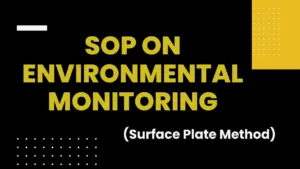SOP on Environmental Monitoring (Surface Plate Method)

SOP on Environmental Monitoring (Surface Plate Method)
1.0 Purpose: This SOP provides a complete description of the method and schedules for taking samples for monitoring the surfaces in all production areas for non-viable and viable counts to ensure compliance with predetermined cleanliness levels.
2.0 Scope: This SOP applies for taking the required samples for the routine monitoring of production areas.
3.0 Responsibility:
3.1 Quality Control microbiologist is responsible for testing microbial count and reporting results.
3.2 Quality Assurance Manager is responsible to ensure that procedure is followed and to investigate if acceptable levels are exceeded.
4.0 Materials and Equipment:
Prepared agar plates
Incubator
Disinfectant for decontaminating surfaces of wrapped plates
Autoclave
Chart of sampling locations for each room
Colony counter
5.0 Procedure:
5.1 Place the prepared agar plates at sampling locations identified.
5.2 Remove the lid of plates and expose the plate for 120 minutes.
5.3 Replace the lid on the plates and then keep in an incubator at 350C ± 20C for 48 hours.
5.4 The counts are done on colony counter by counting the number of colonies.
6.0 Reporting: Fill in record sheets and indicate any deviations to the sampling schedule or procedure and report to Quality Assurance manager.
Frequently Asked Questions (FAQs)
Q1: What is environmental monitoring, and why is it important?
A1: Environmental monitoring involves the regular assessment of the cleanliness and microbial content of surfaces in controlled environments. It is crucial in industries such as pharmaceuticals and food production to ensure product quality and compliance with regulatory standards.
Q2: What is the surface plate method in environmental monitoring?
A2: The surface plate method is a technique where sterile agar plates are used to sample surfaces. These plates are then incubated to allow the growth of microorganisms, providing a quantitative assessment of microbial contamination on the sampled surfaces.
Q3: When and where should environmental monitoring using the surface plate method be conducted?
A3: Environmental monitoring should be conducted regularly, especially in critical areas where product quality is paramount. The frequency and locations for monitoring are determined by the environmental monitoring plan tailored to the specific needs of the facility.
Q4: What equipment and materials are required for the surface plate method?
A4: Required materials include sterile agar plates, sterile swabs or contact plates, an incubator, and personal protective equipment (PPE) such as gloves and lab coats. Ensure all equipment is clean, calibrated, and labeled appropriately.
Q5: How should I interpret the results of the surface plate method?
A5: Examine agar plates after incubation for microbial growth. Record the number and type of colonies. Deviations from established limits should be reported to the Quality Assurance department for investigation and corrective actions.
Q6: What actions should be taken in case of microbial contamination?
A6: If contamination is identified, follow established procedures for investigating the source and implementing corrective actions. This may include enhanced cleaning protocols, revising procedures, or retraining personnel.
Q7: How often should this SOP be reviewed and revised?
A7: Regularly review and revise this SOP as needed to ensure it remains current and effective. Changes should be documented, communicated to relevant personnel, and approved by the appropriate authority.
Q8: Who is responsible for environmental monitoring, and how are personnel trained?
A8: The Environmental Monitoring Team is responsible for executing and documenting monitoring activities. Personnel should be trained on this SOP and related procedures to ensure proper sampling techniques and adherence to guidelines.
Q9: Can the environmental monitoring data be used for trend analysis?
A9: Yes, it is recommended to analyze collected data regularly to identify trends. This analysis helps in making informed decisions, implementing preventive actions, and continuously improving the environmental monitoring program.
Q10: What references should be consulted for additional guidance on environmental monitoring?
A10: Refer to relevant regulatory guidelines, industry standards, and internal policies for additional guidance on environmental monitoring specific to your industry.
Also, Visit:
B. Pharma Notes | B. Pharma Notes | Study material Bachelor of Pharmacy pdf